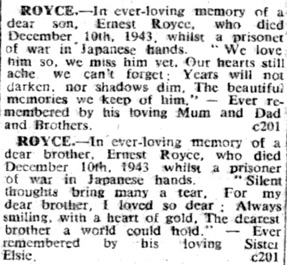Ernest Edward Royce was born and brought up in Springfield. He worked for a sweet manufacturer in Chelmsford before joining the army. He was sent overseas in 1941 and arrived in Singapore in January 1942. He was captured there by the Japanese the following month. He died in captivity in December 1943 in Burma - one of more than 250 men from his battalion killed in Japanese hands, many while working as forced labourers on the notorious Siam to Burma 'Death Railway'. His home was in Springfield Road.
Ernest was born in Springfield on 18th June 1919, the third son of William Royce (1883-1956) and Florence Ellen Royce (nee Ranger) (1884-1965). His parents had married in Essex in 1913. In 1911 Ernest’s father, then a 27 year-old carman on a farm, had been lodging with Florence’s mother in Springfield.
Ernest was baptised at All Saints' Church, Springfield on 20th August 1920. At the time his parents lived in Springfield Street. His father was a packer.
His siblings included William Jack Royce (1914- 2002), Charles Frederick Royce (born in 1916), Frank Sidney Royce (born in 1921), and Elsie Florence Royce (1924-1987).
Ernest was educated at Springfield Boys' and Girls' School in Springfield Green.
Prior to joining the army Ernest was employed by the Chelmsford sweet manufacturers Hawkes Brothers.
During the Second World War Ernest served as Private 6019260 in the 4th Battalion of the Suffolk Regiment. The battalion was sent overseas by ship late in 1941, arriving in Halifax, Nova Scotia, then on to Trinidad before reaching Cape Town, South Africa in December 1941. At that point it seemed to many in the battalion that it was heading for Egypt. However, by the end of the month the battalion was in Bombay, India and on 19th January 1942 it left for Singapore which was threatened by invasion by the Japanese. Ernest and the rest of his battalion arrived in Singapore on 29th January 1942. Six days later it suffered its first casualties in combat. The Japanese advance continued and on 15th February 1942 Ernest along with the rest of the battalion were captured by the Japanese following the surrender of the Commonwealth forces.
Chelmsford's papers did not report confirmation that Ernest was a prisoner of war until June 1943 when he was said to be in Malai camp.
Many of the men in the 4th Battalion of the Suffolk Regiment suffered appallingly through a combination of brutality, disease and starvation. Ernest died whilst a prisoner of war in Japanese hands on 10th December 1943 in Burma. He was 24 years-old and was one of more than 250 men from the battalion to die whilst prisoners of war, many while working as forced labourers on the notorious Siam to Burma 'Death Railway'.
Ernest Edward ROYCE, Private, 4th Battalion, Suffolk Regiment
Died in Burma while a prisoner of war in Japanese hands. Aged 24
The railway, built by Commonwealth, Dutch and American prisoners of war, was a Japanese project driven by the need for improved communications to support the large Japanese army in Burma. During its construction, approximately 13,000 prisoners of war died and were buried along the railway. An estimated 80,000 to 100,000 civilians also died in the course of the project, chiefly forced labour brought from Malaya and the Dutch East Indies, or conscripted in Siam (Thailand) and Burma (Myanmar).
Two labour forces, one based in Siam and the other in Burma worked from opposite ends of the line towards the centre. The Japanese aimed at completing the railway in 14 months and work began in October 1942. The line, 424 kilometres long, was completed by December 1943. Where found the graves of those who died during the construction and maintenance of the railway (except for the Americans, whose remains were repatriated) were transferred from camp burial grounds and isolated sites along the railway into three cemeteries at Chungkai and Kanchanaburi in Siam (now Thailand) and Thanbyuzayat in Burma (now Myanmar).
Ernest has no known grave and is commemorated on the Singapore Memorial and the Springfield War Memorial. Whilst he was serving in the army Ernest's parents were living at 97 Springfield Road in Chelmsford (subsequently renumbered as number 399).
Confirmation of Ernest's death did not reach home until October 1945.
120624
